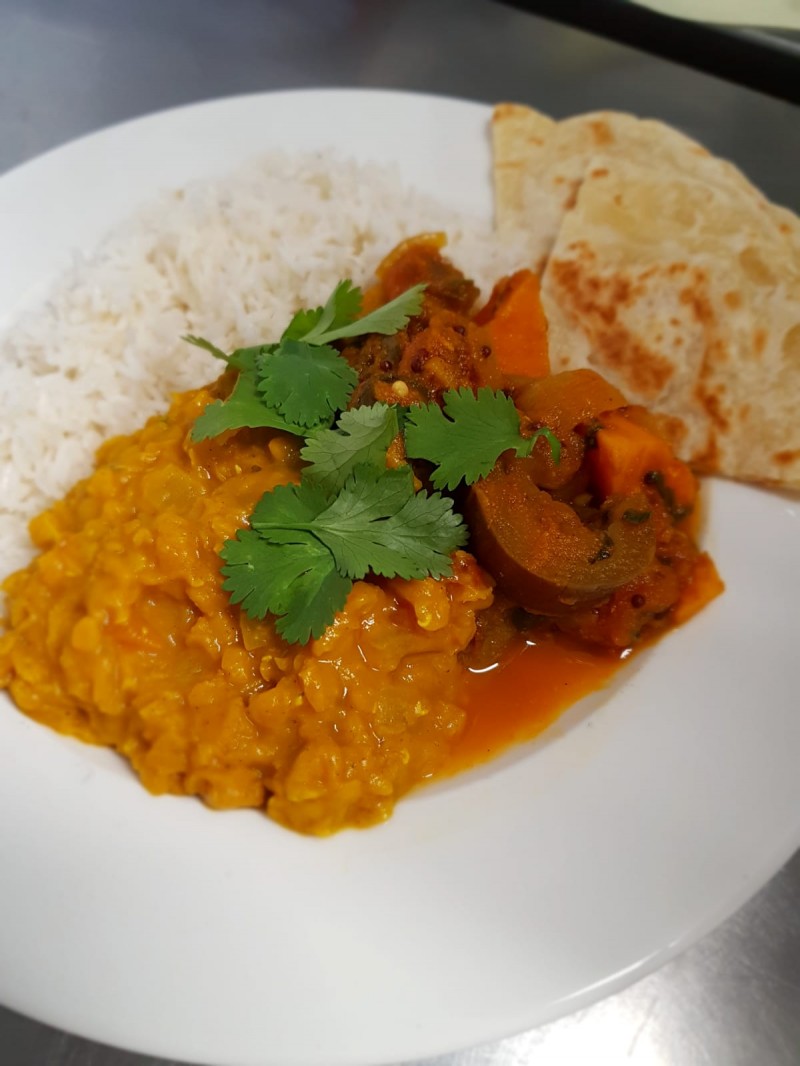
I was recently called to Berry Hill Park Care Home, Nottingham, to help create nutritionally balanced vegetarian meals for a spritely octagenarian resident, originally from East-Central Africa. We'll call him Resident S. Resident S struggled with the menu for a number of reasons, so Head Chef, Deborah enlisted me to come and discuss the care home's current meal plan, and create meals that Resident S would enjoy.
Deborah introduced me to Resident S and we had the chance to discuss his favourite foods, which foods he isn't too keen on, and ingredients he tries to avoid for health reasons. He loves spices, preferring flavoursome Indian dishes to traditional British meals, though he does enjoy some classics such as cake and custard.
Not long ago, one of Resident S' family members came to the home to show Deborah how to create a simple dish using mung beans. Resident S really enjoys this dish, but Deborah was concerned that he needed more variety in his meals. Deborah must follow strict nutritional guidelines for all 41 residents at Berry Hill, but creating new dishes is something she enjoys, so she saw enlisting the help of V for Life as a great way to find out which meals can be easily prepared and satisfy Resident S's specific tastes.

In between Deborah’s busy schedule, I took a short drive to a local world food supermarket called Monsoon to pick up ingredients that aren’t always available in regular supermarkets. I returned with an array of vegetables, pulses, spices, herbs, and breads, and got stuck into creating new dishes.
I began by making a traditional Indian dessert: carrot halwa, made using grated carrots, full-fat milk and spices. I then made two traditional curries: coconut daal and a mixed vegetable curry with pilau rice. Because Resident S is used to traditional vegetarian foods I didn’t want to use any mock-meats, so stuck to pulses for protein and fresh vegetables rich in vitamins and minerals.
Resident S had a great time testing the food, and enjoyed all the dishes that I prepared. The dishes were far richer in spices than other meals served at Berry Hill, but none were too much for Resident S's tastes. I made enough so that some servings could be portioned and frozen. I also explained how each meal could be adapted using different ingredients, providing that variety that Deborah was looking for. The four recipes we made on the day are shown below.
Do you cater for a resident with specific tastes? Or do you know a care home resident who could benefit from the help of a V for Life Roving Chef? Contact us today.
Basmati rice
Serves 4
- 1 cup basmati rice
- 1.5 cup cold water
- 1 tsp ghee/vegetable ghee (optional)
- Soak the basmati rice for 20 minutes in a medium-sized pan, then rinse under cold water until it goes clear.
- Place the rice and water into the pan and cover with a lid, bringing to boil quickly on a high heat. When the water begins to boil, reduce the heat to a slow simmer allowing the rice to absorb the water and cook for 5–9 minutes.
- When the rice is cooked, remove the lid and take the pan off the heat. Leave the rice to stand for around 5 minutes so that the steam is released.
- Just before serving, fluff the rice using a fork. You can also add ghee at this point if you want to add extra calories.
Carrot halwa
Serves 2
- 3 large carrots, peeled and coarsely grated
- 300ml full-fat milk OR use non-dairy milk (do not recommend rice milk because it separates)
- 1 tsp ground green cardamom
- 75g flaked almonds
- 1 tbsp brown sugar
- 1 tbsp ghee/vegetable ghee
- Place all the ingredients except the ghee in a deep milk pan and cook over a medium heat until it begins to simmer.
- Cook the mixture for approximately 20 minutes, or until the milk has evaporated. Make sure the mixture doesn’t stick to the pan.
- Finally, add the ghee and cook for a further 2–3 minutes.
This dish can be served hot or cold. You can also add extra nuts and dried fruit.
Lentil and coconut daal
Serves 6
- 3 tbsp coconut oil or vegetable ghee
- 1 large onion, finely diced
- 4 garlic cloves, crushed and made into a paste
- 1 small green/red chilli
- Large thumb piece of ginger, finely chopped
- 1 tbsp garam masala
- 1 tbsp mild curry powder
- 1 tbsp powdered cumin
- ½ tbsp ground coriander
- 1 tsp ground turmeric
- 1 tbsp tomato purée
- 300g split red lentils, washed
- 1 tin full-fat coconut milk
- 3 cups vegetable stock
- ½ tsp sugar
- Fresh coriander to garnish
- In a large pan, add the coconut oil or vegetable ghee and chopped onions. Turn on the heat and slowly cook for around 5 minutes or until translucent. Raise the heat to medium and add the garlic, chilli and ginger and cook for another 5 minutes.
- Add all the dry spices and tomato purée. Cook for another 2–3 minutes, stirring continoursly to make sure the mixture doesn't burn.
- Add the washed lentils and coat in the onion and spice mixture, making sure it doesn’t stick. Add the tin of coconut milk and add 1 cup of vegetable stock, reduce the heat to a simmer and cover.
- The mixture will thicken quite quickly, so add ½ cup vegetable stock when required and mix well to prevent it sticking. The mixture can cook for 30-45m. If it’s too dry then you can add more coconut milk, stock or water.
- Finish with a wedge of lime and a garnish with fresh coriander.
Mixed vegetable curry
Serves 6–8
- 4 tbsp ghee/vegetable ghee
- 1 extra large white onion, quartered and cut into thick slices
- 5 garlic cloves, crushed and puréed
- 1 x 3-inch piece of ginger, finely grated
- 1 chilli, finely chopped
- 2 large sweet potatoes, cut into 1-inch pieces
- 1 aubergine, cut into 1-inch pieces
- 20 okra pieces, cut into thirds
- 9 large tomatoes, quartered
- 1 litre vegetable stock
- 1 tbsp tomato purée
- 1 tsp black mustard seeds
- 1 tsp hing (also known as asafoetida)
- 1 tbsp curry powder
- 1 tbsp ground cumin
- 1 tbsp ground coriander
- Begin by degorging the aubergine, sprinkle with salt, and placing in a colander to remove excess liquid and put to one side.
- In a large pan add the ghee and sliced onions then turn on the heat and slowly cook for around 5 minutes or until translucent. Raise the heat to a medium and add the garlic, chilli and ginger and cook for another 5 minutes followed by all the dry spices and tomato purée.
- Add the sweet potato and tomatoes and cook for 5 minutes, then add half the stock, cover with a lid but leave a small gap for steam to be released, reduce the heat to a simmer and cook for 15 minutes.
- Rinse the aubergine, and along with the okra add to the curry mixture, stir well and add the remaining stock. Continue to simmer for another 15 minutes or until the sweet potato is cooked.
- Serve with rice and paratha.

